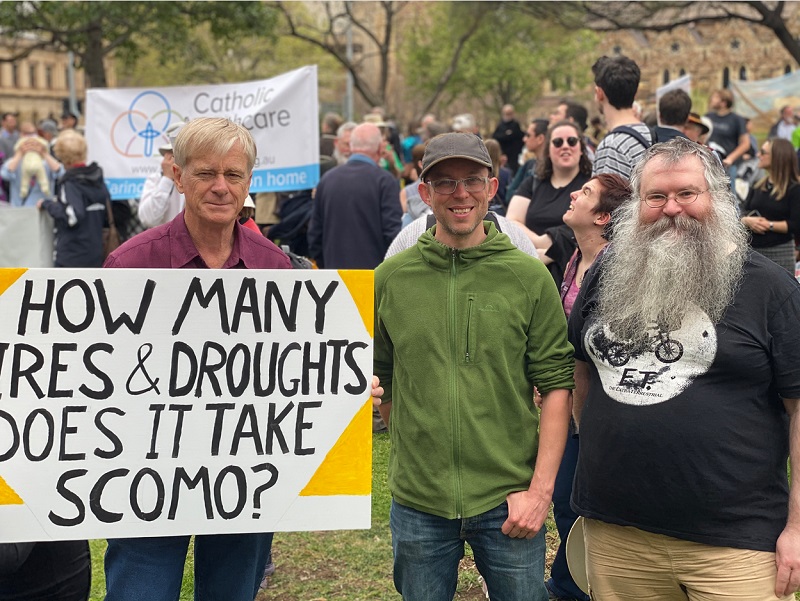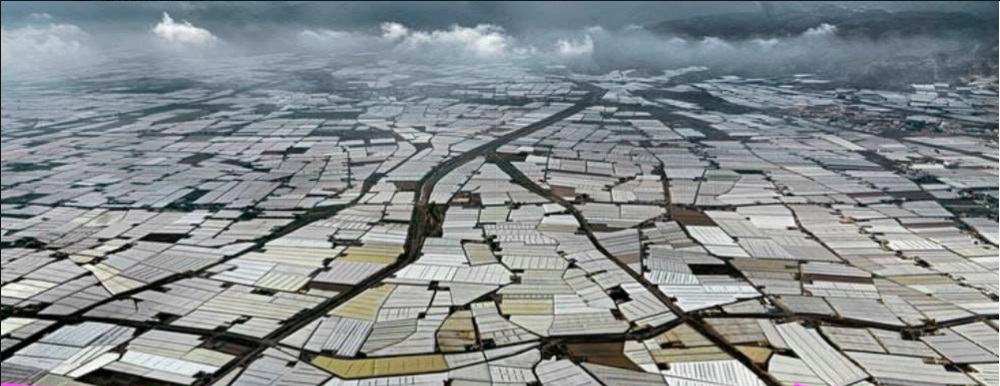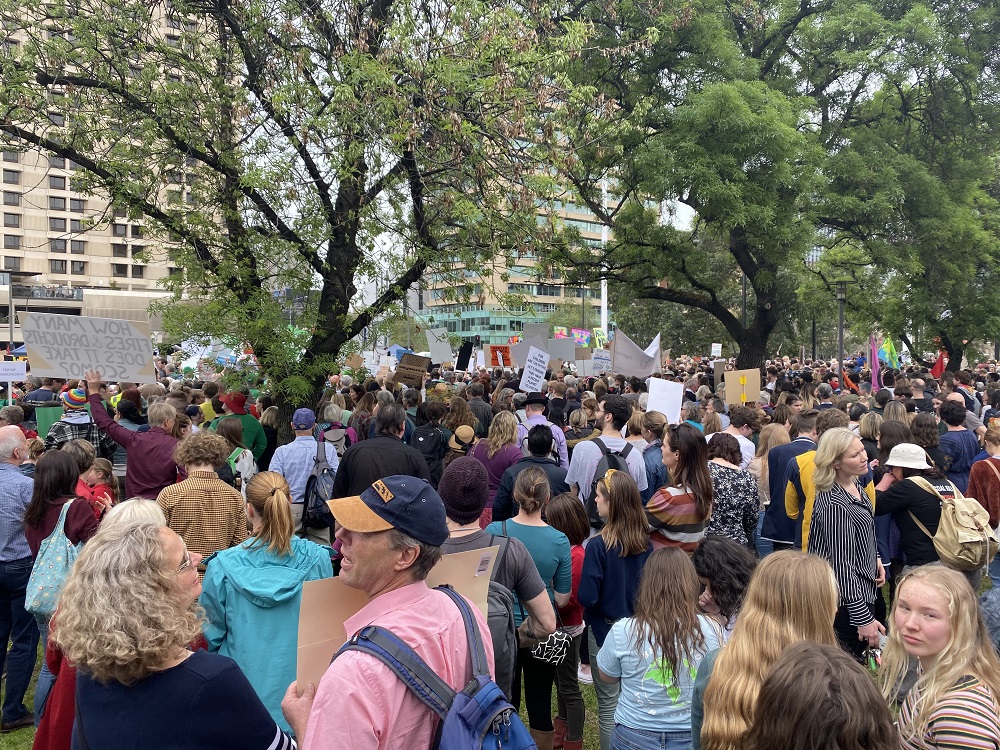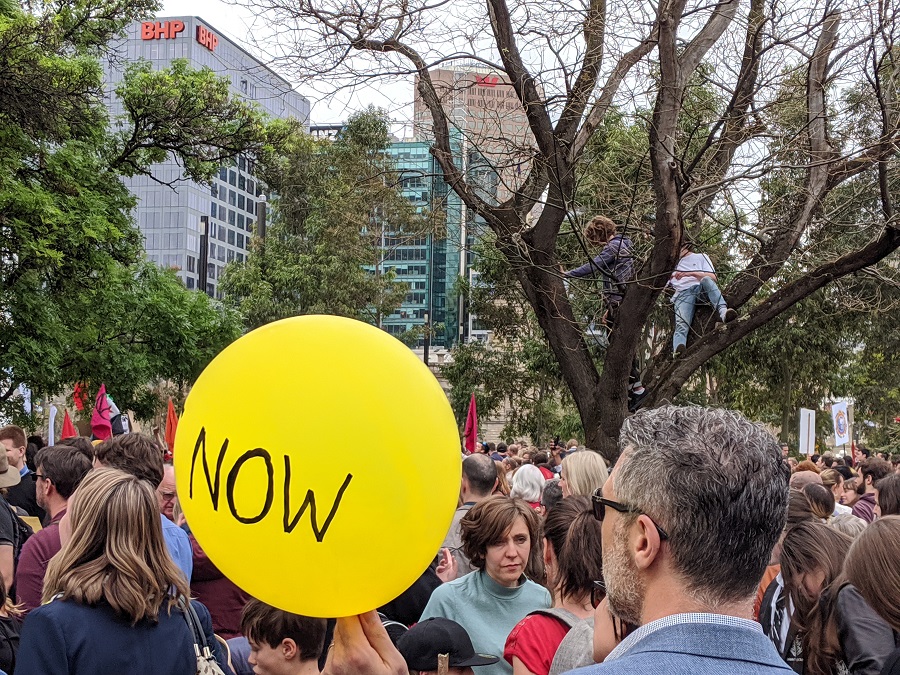
Small Protestors Take To Streets In A Big Way
On Friday I took to the streets as part of the Climate Strike protest. It was something I had to do. Something I owed to my children. Something I owed quite literally, as they had paid me 60 cents to attend.
I told them if they wanted to prevent capitalism destroying the planet they had to learn to use its own weapons against it and pay me to attend. But — damn their mercantile little hearts — they knew my hand was weak as I actually do care about them a bit. I can’t imagine how they worked that out. This leaked information proved expensive as they managed to haggle me down to 20 cents each, despite my insistence I should be paid more since my mass is three times that of the average protester.
Crowd Number = Lots
I didn’t attend with my children but with fellow crew mates of the good ship SolarQuotes. We arrived at Victoria Square a little before the 12:00 noon start and there was already a huge crowd with more people flowing in. It wasn’t long before I felt as though I was standing on Zanzibar. One figure online says there were 8,000 people. I don’t find that at all difficult to believe.

There were some handsome men.
I Can’t Hear You!
The children were down the front. This was fair enough because it was their protest. But the sound system wasn’t very good and we old folk up the back couldn’t make out what was being said. They needed a better sound system. Not a louder one, as cranking up the volume for the hard of hearing elderly at the back is just going to deafen the children in front and perpetuate the cycle. But what the bad sound system taketh away, the good youtube provideth:
A Diverse Crowd
Not being able to hear anything gave me plenty of time to check out the crowd and I noticed the Communist Party of Australia was there. Because I look like the spitting image of Karl Marx I considered charging them $20 to have photographs taken with me, but I decided against it. If they realised who I really was they’d be getting those photos way too cheap.
A Pessimistic Crowd
By dropping eaves on people and even engaging in conversation with them myself, I noticed many had very pessimistic views on climate change and considered worse case climate scenarios likely. But I want everyone to cheer up. You’re not likely to die. If anyone is going to die in countless droves it will be people in poor countries. Not us!
If things turn out worse than expected, don’t worry! It will just be like that movie Blade Runner 2049. Food will be grown in vast greenhouses covering wasteland and there will be giant holographic nude people to distract us from decreased living standards. There probably won’t be any replicants though. Not unless they are an efficient way of producing meat.

This is the opening scene from Blade Runner 2049 and an actual place in Almeria Spain. Desert wrapped in plastic to feed Europe.
Global warming is killing people now. It is likely to kill millions or tens of millions this century and is making us all poorer. If a death toll equal to a World War and not being able to afford to take the kids to Tokyo Disneyland isn’t pessimistic enough for you, then maybe you need to buy some rose tinted contact lenses. The best case scenario is bad enough.
A Determined Crowd
My parents would be willing to give their lives to save mine. I’m not sure if that’s because they love me or just so they won’t have to put up with me anymore. Either way, most parents are willing to make great sacrifices for their children and willing to make them to slow or stop global warming. But I find it kind of funny, I find it kind of strange, the actual sacrifice required is in the none to trivial range.
Big Problem — Cheap Fix
Global warming is contributing to heatwaves, bushfires, floods and other disasters. Sometimes its effects are very clear — there is no doubt higher temperatures contribute to bushfire risk. In other cases we’re unsure what is happening.
Ten years ago it was possible to be concerned that steep cuts in greenhouse gas emissions would come with considerable costs. These days you have to bend over backwards to avoid seeing that the cost of cutting Australia’s emissions ranges from dirt cheap to free.
This is thanks to the costs of renewable energy falling rapidly and Australia’s decrepit coal fleet becoming increasingly unreliable. It is also due to the reduced cost of the battery cells used in electric cars. Both Tesla and Volvo say they pay under $150 per kilowatt-hour for them. (Around $100 US.) We can now be certain electric cars can be competitive with petrol and diesel ones.
Updating estimates of the cost of reducing Australia’s greenhouse gas emissions by 80% or more over 20 years gives an upper limit of roughly around a cup of coffee a day per adult all the way down to free or better than free thanks to lower health costs from reduced pollution.
If we want to go carbon neutral by 2030 that will cost more than getting there over 20-25 years, but the cost will still be trivial for a nation as rich as Australia.
So the Climate Strike hasn’t been a protest about our leaders lacking the courage required to make the huge leaps required to take us to safety. It’s about them being too stupid and pigheaded to take the simple steps required to protect our futures. Our kids have every right to be annoyed by this.
The Slow March Forward
At around 1:30 the Climate Strikers marched on South Australia’s Parliament House. Rather than a climate march, it started off as a climate shuffle and for me never got above a climate stroll. But there were children who were half my height marching and they did us all proud.



 RSS - Posts
RSS - Posts



[Global warming is contributing to heatwaves, bushfires, floods and other disasters.]
The more the merrier… don’t forget hurricanes! Hurricane Alley is where I live, and the monsters have gotten worse. Whether they can be “steered” or not is pure conspiracy theory, but greed and money can’t be ruled out considering Hurricane Harvey was a $128 BILLION DOLLAR operation. During Hurricane Irma, my 20,000-Watt AC Enphase solar system stayed intact, no problems, no damage. I am waiting to upgrade to IQ8 so that I can become grid agnostic. The lines and the poles are the Achilles Heal. Go Enphase Energy!
[Both Tesla and Volvo say they pay under $150 per kilowatt-hour for them. (Around $100 US.)]
Perhaps the question we should be asking is why stationary batteries cost around five times as much? Get it down to $300 per kWh given shipping and marketing costs, and stand back to avoid the rush.
Two reasons: (1) the profit from selling a new car – ANY new car – is subsidizing the cost of the battery. Not necessarily a bad thing, just stating there is a lot of profit to be made in selling cars.
and (2) a lot of solar salespeople are using blended payback to up-sell batteries, even though they aren’t quite economical yet. In this case they are taking advantage of uninformed public opinion to charge extra for the batteries even though they result in _more_ coal being burned.
The changing climate we now see plus what’s to come is probably our blighted world fighting back, starting to cull some of those greedy, destructive humans. But while the climate catastrophe message is cutting through, nobody is keen to actually do much on a personal level.
Most people still think it’s ok to fly somewhere exotic for a Gatsby-style birthday party, or drive a three ton diesel-spewing 4WD behemoth, or support politicians who promote fossil-fuelled power.
Any serious climate action will be too late, for us and the planet.
Robert,
I agree with you Robert that already its apparent that a ‘too little done too late’ scenario is well underway already. That applies to more than just CO2 levels alone – ‘pollution’ of various kinds is also acting to poison things off generally into the bargain.
A current case in point is the city of Newcastle, north of Sydney. At the moment they are grappling with multiple issues:
– severe and rapid erosion of Stockton beach suburb due to extreme weather events, coupled with effects of harbour dredging and associated breakwater construction which has changed wave patterns with the result that no new sand is carried to that beach. Houses and local facilities etc at risk of falling into sea.See: https://www.smh.com.au/national/nsw/tipping-point-coastal-erosion-tearing-away-community-s-heart-20190923-p52u5n.html
More harbour expansion is expected due to plans for the Newcastle port to expand to cater for higher volumes of LNG imports. See:
https://www.pipeliner.com.au/2019/08/21/government-backs-newcastle-lng-project/
– recent discovery that insufficient or in some cases NIL remediation work done to remove lead-contaminated soil from long past mining activity has had housing construction over the top of it. See:
https://www.lakemac.com.au/page.aspx?&pid=1713&vid=28 and also
http://newcastle.nsw.gov.au/Living/Environment/Contaminated-Land
– Plans by Atlas Energy to establish a new and LPG drilling operation offshore of Newcastle – seismic testing is currently underway to verify the extent of the field and the best spot to place drilling facilities. Complete construction is expected by the end of 2020, and gas supply contracts worth $500 million already exchanged with Energy Australia. See:
https://www.pipeliner.com.au/2019/08/21/government-backs-newcastle-lng-project/
Its possible the LNG project ends up being something of a dead-duck LPG prices are trending downwards long-term for a variety of reasons.
The water in Lake Macquarie is itself contaminated with excess levels of cadmium due to both run-off from two coal-powered electricity stations, and also mining operations. Lake Macquarie – which is a saltwater lake – covers 100 sq kilometres, and around 250 tonnes of sea life – especially mud-crabs – is caught by recreational fishermen in a year, so there’s a significant public health issue.
See: https://www.abc.net.au/news/2019-03-11/crabs-lake-macquarie-nsw-contaminated-with-cadmium/10887750
What is concerning too is that the EPA seems to have somewhat failed in its responsibilities regarding public notification of the full extent of the problems.
That may not be the fault of departmental staff though – what they might advise as a course of action to their political masters doesn’t always get listened to or followed..
The region had a population of around 323,000 in 2016, and Newcastle was in 2017 the largest coal exporting harbour in the world, exporting some 169.9 million tonnes of coal.
Obviously, phasing out the coal industry too quickly would adversely affect a LOT of people, so to some extent I can understand the Government’s dilemma.
But, planning to do nothing except plan to do some more planning is never going to achieve anything either.
The local councils in the region do seem to be trying to encourage ‘sustainability’ (reducing waste etc) and are also installing solar PV on their own facilities to cut energy costs.
As you can see from earlier above though, the region has a bucket load of current problems to deal with, and those are more than likely going to become even worse in the near future.
So, despite sudden public interest and concern, and some response by some politicians .. ‘too little being done too late’ is very much my view at the moment, and at best we’ll only partially mitigate the effects of what is already now inevitably on the way.
Seems to me that we are drawing nearer to some kind of ‘tipping point’ far quicker than even most of those who actually recognise there are ‘problems’ currently expect, let alone the ‘ignorance is bliss’ segment of the population.
But rising seas may temporarily save the western economic system, previously kept functioning by apparently limitless growth. As past wars have shown, it’s not substantial growth which is pursued, just rising production and consumption. The projected need to move 180 million people in coastal cities a good distance uphill in coming decades will produce gobs of GDP, piles of profit, and even lift employment. (Jakarta is the first to move, even if some of the 30 million don’t make it to East Kalimantan. The initial budget estimate is a trillion dollars – but at this point any figure will do.)
More productive infrastructure, such as pumped hydro and CST with thermal storage, needed as coal goes through its death throes, will also be good for employment.
The major benefit of global heating is however that reduced food production, due to droughts, fires, and floods, will bring on an earlier peak population at a lower population count. (Probably won’t help the orangutans, though. The forest fires currently raging in Indonesia appear to be at least partly due to landholders razing habitat to make way for yet more oil palms.)
The whole global experiment will leave a scarred planet and yet more extinct species, but then overpopulation was always going to find a way to achieve that. (By the sheer power of mindlessness over matter.)
Erik Christiansen,
You state:
“As past wars have shown, it’s not substantial growth which is pursued, just rising production and consumption. The projected need to move 180 million people in coastal cities a good distance uphill in coming decades will produce gobs of GDP, piles of profit, and even lift employment.”
And where will the affordable, higher Energy Return on Investment (EROI), abundant energy come from to enable these activities, Erik?
I would argue the exponential growth since WW2 has been primarily due to the availability of cheap, higher EROI, abundant petroleum oil. The evidence I see indicates that global supplies of petroleum oil and fossil natural gas are likely to peak in the 2020s and then begin a sustained decline. Where is the cheap, higher EROI, abundant alternative transport energy coming from to continue servicing transport and agricultural applications? And then there’s the existential risk of dangerous climate change – Do you see that being avoided?
See: https://www.ipcn.nsw.gov.au/resources/pac/media/files/pac/projects/2019/05/ulan-coal-mod-4/public-meeting/presentations/geoff-miell-presentation-slides.pptx
Nothing happens without energy – unaffordable energy means life become unaffordable.
Geoff >> And where will the affordable, higher Energy Return on Investment (EROI), abundant energy come from to enable these activities, Erik? <>Nothing happens without energy – unaffordable energy means life become unaffordable.<<
True if "life" is interpreted as "modern western profligate life". A lower population could be supported by slave-like labour behind ox-drawn ploughs, in extremis. A high-tech low-food-miles medium between that and the present is how I see our future.
The roof went on my off-grid build this week, and in the coming months I'll stop burning fossil fuel for lights and power. Room and water heating has been by biomass (stored solar) for 55 years already. Water supply is also solar – rainwater tanks. Sewage goes to a septic tank system. Once I switch to an EV, then it's down to the energy requirements of supplied inputs, and how that's generated.
As a modest corner of Australia's deserts receive sufficient insolation to power the entire world, the only serious engineering challenge is speedily building economic and reliable energy storage. Batteries are still expensive, pumped hydro takes time to build, and state-change thermal storage for CST is moving more slowly that is needed. In first-world countries we have time to make the inevitable transition. Those who say it can't be done are faintly amusing, but in the end they will be disregarded by those making the effort to achieve it incrementally. Whether millions will have to live in tents while their cities are rebuilt uphill depends on how much effort we put in now.
The Indonesian capital of Jakarta is a current example.
After a combination of decades of mismanagement and climate change denialism and associated ‘lack of actually doing anything’ some 240 million people now have to be moved to another island thats 1800 km away, and well above sea-level.
The primary reason is that Jakarta is now rapidly being covered by water, sewage systems getting flooded etc etc… a total nightmare…
So… new capital city still being built, massive billions of $ needs to be spent – mind boggling amounts
The ‘climate change is a hoax’ mob have no idea at all of the consequences they’ve ultimately brought upon others because of their ‘propaganda’. As a result, decisions got made, or not made at all, on the basis that hourly tweets of ‘Climate Change is a Hoax’ from various USA sources were far more reliable than actual facts, scientific forecasts and simple self-evident realities that you only needed to open your eyes in order to see them for yourself, rather than keeping your eyes glued to the latest ‘conspiracy news letter’ .
I must confess that last April 1st, I toyed with the idea of making a post on some of those news letters asserting that the real Donald Trump died some 15 years ago, and that actually its Hillary Clinton in disguise who is now impersonating him (and has been all along unknown to everybody) with the help of her expert make-up artist friends in Hollywood (who are actually a secret group working for Russia) … but decided that some-one might actually believe me.
Erik Christiansen,
You state:
“True if “life” is interpreted as “modern western profligate life”.”
I mean life in general, NOT just “modern western profligate life”. If you can’t afford energy, and I include food as energy, then you can’t afford to live.
You then state:
“A lower population could be supported by slave-like labour behind ox-drawn ploughs, in extremis.”
I note that slavery in the western world wasn’t abolished until around the mid-1800s, at roughly about the time that coal-based energy and industrialisation started expanding (give or take a few decades).
See: https://en.wikipedia.org/wiki/Abolitionism
Also: https://en.wikipedia.org/wiki/Industrial_Revolution
Fossil fuels have demonstrated that they provide far more useful mechanical work than any muscle-power from humans (or animals) can.
You then follow with:
“A high-tech low-food-miles medium between that and the present is how I see our future.”
For that to be sustainable, it still requires affordable, abundant, long-term sustainable, higher EROI energy systems supporting these processes. If you don’t have that, then the technological systems that support our civilisation will collapse. No energy – no technology.
You say:
“Once I switch to an EV, then it’s down to the energy requirements of supplied inputs, and how that’s generated.”
Everything fails eventually, and then requires fixing or replacement. What then, Erik? IMO, you still need an ongoing, sustainable industry to support your activities when your setup requires fixing/repairs/replacements. Or do you think you can fix EVERYTHING without outside help or materials?
This statement of yours:
“As a modest corner of Australia’s deserts receive sufficient insolation to power the entire world, the only serious engineering challenge is speedily building economic and reliable energy storage.”
…suggests to me you have little understanding of the importance of petroleum oil that has enabled where human civilisation has come to be at present. Erik, what available, affordable, rapidly deployable technologies do you see that can enable the rapid transition away from petroleum dependency for:
• Aviation (particularly long-distance)?
• Shipping?
• and agriculture?
IMO, humanity will need to come-up with some effective solutions, deployed quickly, otherwise I think the way we currently live is not sustainable into the 2020s and beyond.
See: https://crudeoilpeak.info/the-attacks-on-abqaiq-and-peak-oil-in-ghawar
This statement of yours:
“Those who say it can’t be done are faintly amusing, but in the end they will be disregarded by those making the effort to achieve it incrementally.”
…suggests to me you don’t see any urgency to act on dangerous climate change (or to mitigate a post- ‘peak oil’ and post- ‘peak gas’ world). IMO, an incremental change won’t cut it now – a step change is required!
See: http://www.climatecodered.org/2019/08/at-4c-of-warming-would-billion-people.html